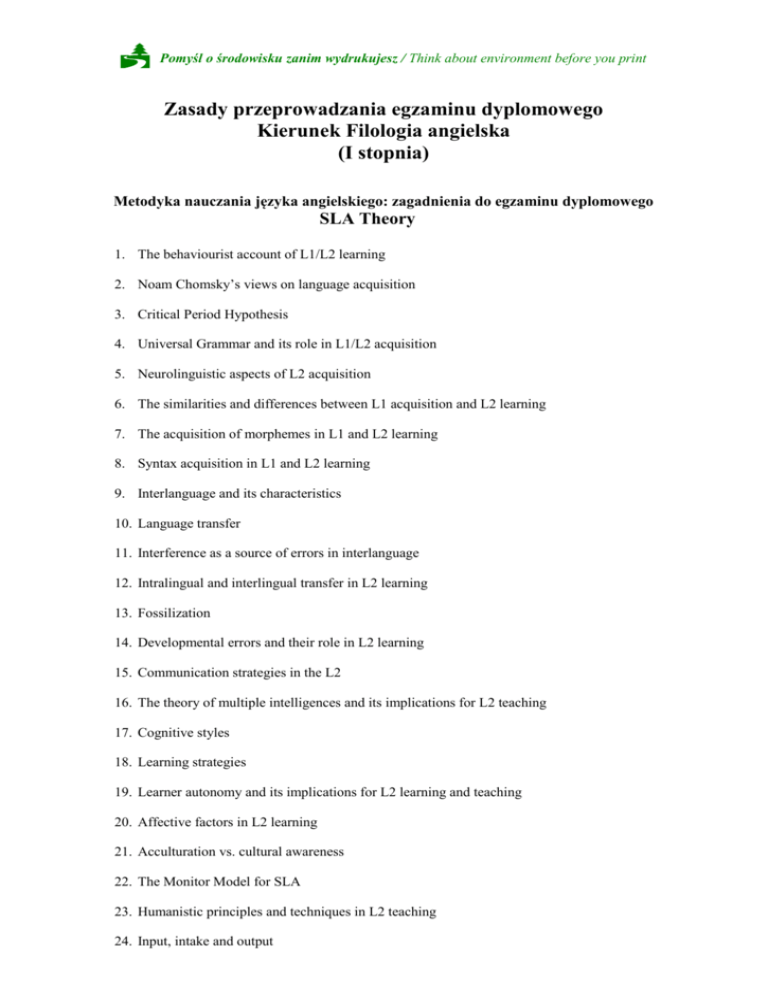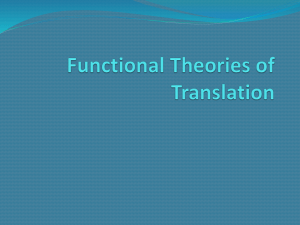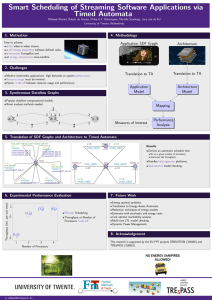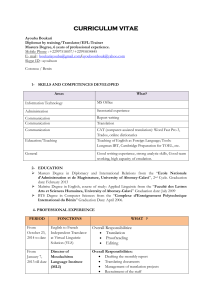Filologia angielska
advertisement

Pomyśl o środowisku zanim wydrukujesz / Think about environment before you print Zasady przeprowadzania egzaminu dyplomowego Kierunek Filologia angielska (I stopnia) Metodyka nauczania języka angielskiego: zagadnienia do egzaminu dyplomowego SLA Theory 1. The behaviourist account of L1/L2 learning 2. Noam Chomsky’s views on language acquisition 3. Critical Period Hypothesis 4. Universal Grammar and its role in L1/L2 acquisition 5. Neurolinguistic aspects of L2 acquisition 6. The similarities and differences between L1 acquisition and L2 learning 7. The acquisition of morphemes in L1 and L2 learning 8. Syntax acquisition in L1 and L2 learning 9. Interlanguage and its characteristics 10. Language transfer 11. Interference as a source of errors in interlanguage 12. Intralingual and interlingual transfer in L2 learning 13. Fossilization 14. Developmental errors and their role in L2 learning 15. Communication strategies in the L2 16. The theory of multiple intelligences and its implications for L2 teaching 17. Cognitive styles 18. Learning strategies 19. Learner autonomy and its implications for L2 learning and teaching 20. Affective factors in L2 learning 21. Acculturation vs. cultural awareness 22. The Monitor Model for SLA 23. Humanistic principles and techniques in L2 teaching 24. Input, intake and output 25. Foreigner talk and its role in L2 learning 26. Contrastive analysis vs. error analysis 27. Error analysis and its contribution to SLA theory 28. Interference vs. overgeneralization 29. Learning styles 30. Approach, method and technique 31. Communicative competence 32. Communicative Language Teaching 33. Eclecticism in L2 teaching 34. The Audiolingual Method 35. Suggestopedia 36. The Silent Way 37. Community Language Learning 38. Total Physical Response 39. The silent period in L2 teaching 40. The Natural Approach 41. The Grammar Translation Method 42. The Direct Method 43. Conventional and unconventional methods of L2 teaching ELT Methodology 44. Language skills and subsystems 45. Integrated skills 46. Inductive vs. deductive teaching 47. The PPP model of L2 teaching 48. Stages of a foreign language lesson 49. Free practice vs. controlled practice 50. Pre-teaching and its role in L2 teaching 51. Revision and its role in L2 teaching 52. Types and characteristics of language tests 53. The backwash effect 54. Testing techniques 55. Discrete-point testing techniques 56. Techniques for testing listening comprehension 57. Techniques for testing reading comprehension 58. Techniques for testing speaking 59. Techniques for testing writing 60. Techniques for testing vocabulary 61. Techniques for testing grammar 62. The syllabus 63. Course-book evaluation 64. Lesson planning 65. Realia and their role in L2 teaching 66. Authentic materials 67. The role of L1 in L2 teaching 68. Error correction 69. Techniques for correcting written work 70. Techniques for correcting oral mistakes 71. Metalanguage and its usage in L2 teaching 72. Audio-visual aids in L2 teaching 73. Video materials in L2 teaching 74. CALL and its application in L2 teaching 75. Pairwork 76. Teaching young learners 77. Developing speaking skills 78. Developing listening skills 79. Developing writing skills at the beginner level 80. Developing writing skills at an advanced level 81. Developing reading skills 82. Skimming, scanning and reading for detail 83. Characteristics of effective listening activities 84. Developing fluency in the L2 85. Establishing L2 pronunciation goals 86. Teaching L2 pronunciation 87. Teaching L2 vocabulary 88. Translation in vocabulary teaching 89. Vocabulary presentation techniques 90. Teaching idioms and collocations 91. Teaching English consonants to Poles 92. Teaching English vowels to Poles 93. Researching classroom interaction 94. Role-play activities 95. Feedback 96. Teaching L2 grammar 97. Peer-correction vs. self-correction 98. Reading aloud: arguments for and against its use 99. Teacher roles in a communicative class 100. Information gap and its implications for L2 teaching 101. Pedagogical grammar 102.Developing cultural awareness 103.Native speakers vs. non-native speaker teachers 104.Homework Językoznawstwo: zagadnienia do egzaminu dyplomowego 1. Levels of linguistic investigation according to the unit of description 2. Linguistic competence versus linguistic performance 3. Prescriptive versus descriptive grammar 4. Phonetics versus phonology 5. Articulatory, acoustic and auditory phonetics 6. The reasons for differences between spelling and pronunciation in the English language 7. International phonetic alphabet, diacritics and types of transcription 8. The notions of phoneme, phone and allophone 9. Articulatory features of English consonants 10. Places of articulation of English consonants 11. Manners of articulation of English consonants 12. The voiced-voiceless, oral-nasal and central-lateral oppositions 13. Major allophonic variants of English nasals and approximants 14. Major allophonic variants of English plosives 15. Allophonic processes affecting vowels in English 16. The notions of aspiration, syllabic consonants, nasal and lateral release 17. The structure of a syllable and phonotactic constraints in English 18. Linking and intrusive /r/ in English 19. The problems with the definition of the term “word” 20. The notions of lexeme, word-form, phonological word, orthographic word and grammatical word 21. The notions of morpheme, morph and allomorph 22. Types of conditioning of allomorphy 23. Inflection versus derivation 24. Concatenative morphological processes 25. Non-concatenative morphological processes 26. Word-manufacturing processes 27. The notions of suppletion, zero morph and empty morph 28. Types of affixes 29. Types of compounds 30. The notions of stem, base and root 31. Content words and function words Język techniczny i biznesu: zagadnienia do egzaminu dyplomowego 1. Business English vs General English vs English for Specific Purposes 2. English for Specific Purposes (ESP) vs Plain English 3. English for Professional Purposes vs Plain English 4. Features of English as a Lingua Franca 5. Needs analysis –definition and reasons for implementing it 6. The distinguishing features of key business genres 7. Business genres 8. Characteristic features of Business communication 9. Types of translation (human, mechanical, computer-aided) 10. The role of the translator 11. Audiovisual translation (AVT) 12. Computer-assisted translation (CAT) 13. Translation vs interpretation 14. Equivalence in translation 15. Global vs local translation strategies 16. Translation methods: (word-for-word translation, literal, faithful, semantic, communicative, idiomatic, free, adaptation) 17. Local translation strategies / translation procedures 18. Translating/interpreting constraints 19. The principles of translating technical language SPRAWDZIAN KOMPETENCYJNY* Elementem egzaminu dyplomowego jest przeprowadzenie sprawdzianu kompetencyjnego, którego celem jest dodatkowa weryfikacja efektów kształcenia, tj. sprawdzenie, czy student osiągnął efekty kształcenia określone dla danego kierunku studiów. Sprawdzian kompetencyjny ma formę prezentacji przygotowywanej przez studenta i przedstawianej na egzaminie dyplomowym oraz dyskusji na temat treści prezentacji z udziałem komisji przeprowadzającej egzamin dyplomowy. Prezentacja, stanowiąca istotę sprawdzianu kompetencyjnego, dotyczy tematycznie pracy dyplomowej. W prezentacji tej student w szczególności uzasadnienia podjęcie danego tematu pracy, wskazując na jej ewentualne zastosowania praktyczne, charakteryzuje dorobek naukowy istniejący w danym zakresie, osadza temat w literaturze przedmiotu, przedstawia tezy pracy i sformułowane wnioski, omawia stosowane metody badawcze i przeprowadzone badania (jeśli praca miała charakter badawczy), a przede wszystkim prezentuje uzyskane wyniki. Przygotowana przez studenta prezentacja może mieć charakter multimedialny. Wynik sprawdzianu kompetencyjnego ma dla Uczelni wyłącznie charakter informacji zwrotnej na temat tego, czy student osiągnął efekty kształcenia określone dla danego kierunku studiów i nie wpływa na ostateczny wynik studiów. *Dotyczy egzaminów dyplomowych odbywających się po 1 stycznia 2012 roku.








